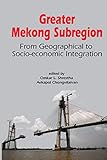Greater Mekong Subregion : From Geographical to Socio-economic Integration / ed. by Omkar Lal Shrestha, Aekapol Chongvilaivan.
Material type: TextPublisher: Singapore : ISEAS Publishing, [2013]Copyright date: ©2013Description: 1 online resource (270 p.)Content type:
TextPublisher: Singapore : ISEAS Publishing, [2013]Copyright date: ©2013Description: 1 online resource (270 p.)Content type: - 9789814379687
- 9789814379694
- 337.15978 23
- online - DeGruyter
| Item type | Current library | Call number | URL | Status | Notes | Barcode | |
|---|---|---|---|---|---|---|---|
 eBook
eBook
|
Biblioteca "Angelicum" Pont. Univ. S.Tommaso d'Aquino Nuvola online | online - DeGruyter (Browse shelf(Opens below)) | Online access | Not for loan (Accesso limitato) | Accesso per gli utenti autorizzati / Access for authorized users | (dgr)9789814379694 |
Frontmatter -- Contents -- PREFACE -- ABBREVIATIONS -- CONTRIBUTORS -- 1. Greater Mekong Subregion -- 2. Cambodia, Its Development, and Integration INTO the GMS -- 3. Subregional Connectivity in THE Lao PDR -- 4. The Economic Development of Myanmar and the Relevance of the Greater Mekong Subregion -- 5. GMS Challenges for Thailand -- 6. Deepening GMS Cooperation in A More Integrated ASEAN and East Asia -- 7. China (Yunnan)–GMS Economic Cooperation -- 8. Trade and Investment in the Greater Mekong Subregion -- 9. Enhancing Financial Cooperation among the GM S Countries -- 10. The Challenges of GMS Regional Integration -- 11. Energy Sector Integration for Low-Carbon Development in GMS -- 12. Linking the Social to the Economic -- INDEX
restricted access online access with authorization star
http://purl.org/coar/access_right/c_16ec
The large market size and abundant resources of the Greater Mekong Subregion (GMS), including a large, motivated and cheap workforce, a rich agricultural base, extensive timber and fisheries resources, considerable potential mineral resources, and vast energy resources have seen the subregion increasingly recognized as a new frontier of Southeast Asian economic strength. This book aims to assess the recent economic, social and political developments in the GMS and identify emerging opportunities and challenges facing the successful transition towards a market-driven economy. The countries of the GMS are at a critical juncture where subregional efforts and cooperation must be made to fully address the rapidly evolving issues that are vital to appropriate policy formation, yet which remain widely debatable. The deliberations here shed light on the development stages and offer policy recommendations for pushing forward subregional cooperation.
Mode of access: Internet via World Wide Web.
In English.
Description based on online resource; title from PDF title page (publisher's Web site, viewed 01. Dez 2022)


